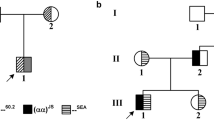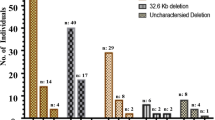Abstract
Inherited deletions of α-globin genes and/or their upstream regulatory elements (MCSs) give rise to α-thalassemia, an autosomal recessive microcytic hypochromic anemia. In this study, multiplex ligation-dependent probe amplification performed with commercial and synthetic engineered probes, Gap-PCR, and DNA sequencing were used to characterize lesions in the sub-telomeric region of the short arm of chromosome 16, possibly explaining the α-thalassemia/HbH disease phenotype in ten patients. We have found six different deletions, in heterozygosity, ranging from approximately 3.3 to 323 kb, two of them not previously described. The deletions fall into two categories: one includes deletions which totally remove the α-globin gene cluster, whereas the other includes deletions removing only the distal regulatory elements and keeping the α-globin genes structurally intact. An indel was observed in one patient involving the loss of the MCS-R2 and the insertion of 39 bp originated from a complex rearrangement spanning the deletion breakpoints. Finally, in another case, no α-globin gene cluster deletion was found and the patient revealed to be a very unusual case of acquired α-thalassemia-myelodysplastic syndrome. This study further illustrates the diversity of genomic lesions and underlying molecular mechanisms leading to α-thalassemia.



Similar content being viewed by others
References
Higgs DR (2013) The molecular basis of α-thalassemia. Cold Spring Harb Perspect Med 3(1):a011718. doi:10.1101/cshperspect.a011718
Hatton CS, Wilkie AO, Drysdale HC, Wood WG, Vickers MA, Sharpe J, Ayyub H, Pretorius IM, Buckle VJ, Higgs DR (1990) Alpha-thalassemia caused by a large (62kb) deletion upstream of the human alpha globin gene cluster. Blood 76(1):221–227
Romão L, Osorio-Almeida L, Higgs DR, Lavinha J, Liebhaber SA (1991) α-Thalassemia resulting from deletion of regulatory sequences far upstream of the α-globin structural gene. Blood 78(6):1589–1595
Viprakasit V, Kidd AM, Ayyub H, Horsley S, Hughes J, Higgs DR (2003) De novo deletion within the telomeric region flanking the human alpha globin locus as a cause of alpha thalassaemia. Br J Haematol 120(5):867–875. doi:10.1046/j.1365-2141.2003.04197.x
Viprakasit V, Harteveld CL, Ayyub H, Stanley JS, Giordano PC, Wood WG, Higgs DR (2006) A novel deletion causing α-thalassemia clarifies the importance of the major human alpha globin regulatory element. Blood 107(9):3811–3812. doi:10.1182/blood-2005-12-4834
Phylipsen M, Prior JF, Lim E, Lingam N, Vogelaar IP, Giordano PC, Finlayson J, Harteveld CL (2010) Thalassemia in Western Australia: 11 novel deletions characterized by multiplex ligation-dependent probe amplification. Blood Cells Mol Dis 44(3):146–151. doi:10.1016/j.bcmd.2009.12.011
Coelho A, Picanço I, Seuanes F, Seixas MT, Faustino P (2010) Novel large deletions in the human α-globin gene cluster: clarifying the HS-40 long-range regulatory role in the native chromosome environment. Blood Cells Mol Dis 45(2):147–153. doi:10.1016/j.bcmd.2010.05.010
Weatherall DJ, Higgs DR, Bunch C, Old JM, Hunt DM, Pressley L, Clegg JB, Bethlenfalvay NC, Sjolin S, Koler RD, Magenis E, Francis JL, Bebbington D (1981) Hemoglobin H disease and mental retardation: new syndrome or a remarkable coincidence? N Engl J Med 305(11):607–612. doi:10.1056/NEJM198109103051103
Harteveld CL, Kriek M, Bijlsma EK, Erjavec Z, Balak D, Phylipsen M, Voskamp A, di Capua E, White SJ, Giordano PC (2007) Refinement of the genetic cause of ATR-16. Hum Genet 122(3–4):283–292. doi:10.1007/s00439-007-0399-y
Gibbons RJ, Suthers GK, Wilkie AO, Buckle VJ, Higgs DR (1992) X-linked alpha-thalassaemia/mental retardation (ATR-X) syndrome: localization to Xq12-q21.31 by X inactivation and linkage analysis. Am J Hum Genet 51(5):1136–1149
Picketts DJ, Higgs DR, Bachoo S, Blake DJ, Quarrell OW, Gibbons RJ (1996) ATRX encodes a novel member of the SNF2 family of proteins: mutations point to a common mechanism underlying the ATR-X syndrome. Hum Mol Genet 5(12):1899–1907. doi:10.1093/hmg/5.12.1899
Steensma DP, Viprakasit V, Hendrick A, Goff DK, Leach J, Gibbons RJ, Higgs DR (2004) Deletion of the α-globin gene cluster as a acquired α-thalassemia in myelodysplastic syndrome. Blood 103(4):1518–1520. doi:10.1182/blood-2003-09-3222
Steensma DP, Gibbons RJ, Higgs DR (2005) Acquired α-thalassemia in association with myelodysplastic syndrome and other hematologic malignancies. Blood 105(2):443–452. doi:10.1182/blood-2004-07-2792
Steensma DP, Higgs DR, Fisher CA, Gibbons RJ (2004) Acquired somatic ATRX mutations in myelodysplastic syndrome associated with α thalassaemia (ATMDS) convey a more severe hematologic phenotype than germline ATRX mutations. Blood 103(6):2019–2026. doi:10.1182/blood-2003-09-3360
Nelson ME, Thurmes PJ, Hoyer JD, Steensma DP (2005) A novel 5’ATRX mutation with splicing consequences in acquired alpha thalassaemia-myelodysplastic syndrome. Haematologica 90(11):1463–1470
Gibbons RJ (2012) α-Thalassemia, mental retardation, and myelodysplastic syndrome. Cold Spring Harb Perspect Med 2(10):a011759. doi:10.1101/cshperspect.a011759
Herbaux C, Duployez N, Badens C, Poret N, Gardin C, Decamp M, Eclache V, Daliphard S, Murati A, Cony-Makhoul P, Cheze S, Beve B et al (2015) Incidence of ATRX mutations in myelodysplastic syndromes, the value of microcytosis. Am J Hematol 90(8):737–738. doi:10.1002/ajh.24073
Dodé C, Krishnamoorthy R, Lamb J, Rochette J (1993) Rapid analysis of -alpha 3.7 thalassaemia and alpha alpha alpha anti 3.7 triplication by enzymatic amplification analysis. Br J Haematol 83(1):105–111. doi:10.1111/j.1365-2141.1993.tb04639.x
Liu YT, Old JM, Miles K, Fisher CA, Weatherall DJ, Clegg JB (2000) Rapid detection of alpha-thalassaemia deletions and alpha-globin gene triplication by multiplex polymerase chain reactions. Br J Haematol 108(2):295–299. doi:10.1046/j.1365-2141.2000.01870.x
Chong SS, Boehm CD, Higgs DR, Cutting GR (2000) Single-tube multiplex-PCR screen for common deletional determinants of alpha-thalassemia. Blood 95(1):360–362
Harteveld CL, Voskamp A, Phylipsen M, Akkermans N, den Dunnen JT, White SJ, Giordano PC (2005) Nine unknown rearrangements in 16p13.3 and 11p15.4 causing α and β-thalassaemia characterised by high resolution multiplex ligation-dependent probe amplification. J Med Genet 42(12):922–931. doi:10.1136/jmg.2005.033597
Harteveld CL (2014) State of the art and new developments in molecular diagnostics for hemoglobinopathies in multi-ethnic societies. Int J Lab Hematol 36(1):1–12. doi:10.1111/ijlh.12108
Giordano PC (2013) Strategies for basic laboratory diagnostics of the hemoglobinopathies in multi-ethnic societies: interpretation of results and pitfalls. Int J Lab Hematol 35(5):465–479. doi:10.1111/ijlh.12037
Sollaino MC, Paglietti ME, Loi D, Congiu R, Podda R, Galanello R (2010) Homozygous deletion of the major alfa-globin regulatory element (MCS-R2) responsible for a severe case of hemoglobin H disease. Blood 116(12):2193–2194. doi:10.1182/blood-2010-04-281345
Zuker M (2003) Mfold web server for nucleic acid folding and hybridization prediction. Nucleic Acids Res 31(13):3406–3415. doi:10.1093/nar/gkg595
NCBI Resource Coordinators (2016) Database resources of the National Center for Biotechnology Information. Nucleic Acids Res 44(D1):D7–D19. doi:10.1093/nar/gkv1290
Wu MY, He Y, Yan JM, Li DZ (2017) A novel selective deletion of the major α-globin regulatory element (MCS-R2) causing α-thalassaemia. Br J Haematol 176(6):984–986. doi:10.1111/bjh.14005
Vernimmen D (2014) Uncovering enhancer functions using the α-globin locus. PLoS Genet 10(10):e1004668. doi:10.1371/journal.pgen.1004668
Onozawa M, Goldberg L, Aplan PD (2015) Landscape of insertion polymorphisms in the human genome. Genome Biol Evol 7(4):960–968. doi:10.1093/gbe/evv043
Davids MS, Steensma DP (2010) The molecular pathogenesis of myelodysplastic syndromes. Cancer Biol Ther 10(4):309–319. doi:10.4161/cbt.10.4.12612
Acknowledgements
We would like to thank Unidade de Tecnologia e Inovação, DGH, INSA, for the technical support.
Author information
Authors and Affiliations
Contributions
JF, MS, LG, SG, and PL performed the research laboratorial work. AC designed the synthetic probes. AM and FS performed the hematological characterization of patient 10. PF designed the research study, reviewed the study results, performed genotype/phenotype correlations, and wrote the manuscript. JF, MS, and JG reviewed literature/databases and co-wrote the manuscript. ABR, FP, RM, PK, EM, and JFL participated in clinical enrolling/work-up of patients. JL performed a critical revision of the manuscript. All authors revised and approved the manuscript final version.
Corresponding author
Ethics declarations
This study was conducted in accordance with the ethical standards of the institutional research committee and with the 1964 Helsinki Declaration and its later amendments or comparable standards.
All persons, or their legal representatives, gave their informed consent prior to their inclusion in the study.
Conflict of interest
The authors declare that they have no conflict of interest.
Electronic supplementary material
Rights and permissions
About this article
Cite this article
Ferrão, J., Silva, M., Gonçalves, L. et al. Widening the spectrum of deletions and molecular mechanisms underlying alpha-thalassemia. Ann Hematol 96, 1921–1929 (2017). https://doi.org/10.1007/s00277-017-3090-y
Received:
Accepted:
Published:
Issue Date:
DOI: https://doi.org/10.1007/s00277-017-3090-y




